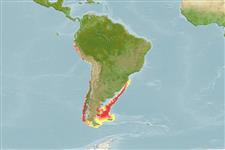Elasmobranchii (sharks and rays) >
Rajiformes (Skates and rays) >
Rajidae (Skates)
Etymology: Dipturus: Greek, di = two + Greek, pteryx = fin (Ref. 45335).
Environment: milieu / climate zone / depth range / distribution range
Ecology
Marine; bathydemersal; depth range 93 - 450 m (Ref. 27092). Deep-water; 22°S - 57°S, 99°W - 42°W
Southeast Pacific: Chile to Southwest Atlantic: Argentina, Uruguay and Brazil.
Length at first maturity / Size / Weight / Age
Maturity: Lm 215.0, range 200 - ? cm
Max length : 264 cm TL male/unsexed; (Ref. 114953); max. published weight: 0.00 g
Occurs on sandy and muddy bottoms of outer continental shelf and upper slope, also found at shallower depth 20m. Feeds mainly on bony fishes and crustaceans (Ref. 114953). Oviparous (Ref. 50449). Eggs have horn-like projections on the shell (Ref. 205); egg cases ca. 20-30 cm long (Ref. 114953). Reaches maturity at ca. 13 years (Ref. 114953).
Life cycle and mating behavior
Maturity | Reproduction | Spawning | Eggs | Fecundity | Larvae
Oviparous, paired eggs are laid. Embryos feed solely on yolk (Ref. 50449).
McEachran, J.D. and K.A. Dunn, 1998. Phylogenetic analysis of skates, a morphologically conservative clade of elasmobranchs (Chondrichthyes: Rajidae). Copeia 1998(2):271-290. (Ref. 27314)
IUCN Red List Status (Ref. 130435: Version 2024-1)
Threat to humans
Harmless
Human uses
Fisheries: commercial
Tools
Special reports
Download XML
Internet sources
Estimates based on models
Preferred temperature (Ref.
123201): 4.7 - 12.2, mean 6 °C (based on 124 cells).
Phylogenetic diversity index (Ref.
82804): PD
50 = 0.5000 [Uniqueness, from 0.5 = low to 2.0 = high].
Bayesian length-weight: a=0.00234 (0.00158 - 0.00348), b=3.18 (3.06 - 3.30), in cm total length, based on LWR estimates for this species & Genus-body shape (Ref.
93245).
Trophic level (Ref.
69278): 4.1 ±0.6 se; based on size and trophs of closest relatives
Resilience (Ref.
120179): Low, minimum population doubling time 4.5 - 14 years (Assuming fecundity<100).
Fishing Vulnerability (Ref.
59153): Very high vulnerability (90 of 100).
Nutrients (Ref.
124155): Calcium = 4.39 [0.76, 23.72] mg/100g; Iron = 0.315 [0.076, 0.995] mg/100g; Protein = 16.6 [13.8, 19.3] %; Omega3 = 0.4 [0.1, 1.5] g/100g; Selenium = 16.3 [4.2, 57.8] μg/100g; VitaminA = 6.16 [1.35, 29.16] μg/100g; Zinc = 0.258 [0.123, 0.485] mg/100g (wet weight);
